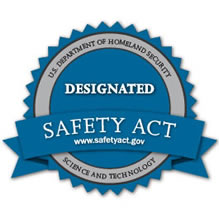
 CYBER SECURITY & SAFETY: IT'S NOT JUST FOR KIDS
LeapFrog Solutions, Inc. | Fairfax, VA
InfraGard National Capital Region Members Alliance (INCRMA) invites you to a discussion of cyber security and privacy regarding your personal assets - your identity and your children. In the wake of the recent VISA card data breach and as school-aged children are returning to schools, colleges, and universities across the country, this topic is relevant and timely! Keynote Brian Finch has been interviewed by numerous news outlets on the breach and its ramifications for personal and corporate security. Other speakers will discuss government and industry efforts to secure your personal information and bring your attention to a number of precautions you can take to secure your business and family. Confirmed Speakers: Opening Keynote: The VISA Card Breach - Your information is not as safe as you think! Brian Finch, Partner, Dickstein Shapiro LLP Panel Discussion: Best Practices & Programs for Practical Cyber Safety Solutions Schnearia Ashley, BB&T At Work, BB&T, Bank Kristina Dorville, Program Manager, Cyber Security Awareness Programs, National Protection & Programs Directorate, DHS Steve Howard, Executive Director, TecPort Solutions' Cyber Defense and Compliance, Forensics Services Division Andrew Leithead, Supervisory Special Agent, Hybrid Child Exploitation Task Force in Washington, DC and Northern Virginia, Washington Field Division, FBI Russell Vines, Chief Security Advisor, Gotham Technology Group Industry Case Study: CareerSafe National Cyber Security Program for High School Students and Teachers Larry Teverbaugh, CEO, CareerSafe & K2Share
|

 THE SAFETY ACT WEBINAR HOSTED BY OSAI
*Register via Internet Explorer or Safari
The SAFETY Act provides important legal liability protections for providers of Qualified Anti-Terrorism Technologies - whether they are products or services. The goal of the SAFETY Act is to encourage the development and deployment of new and innovative anti-terrorism products and services by providing liability protections. GTSC encourages all businesses to decide whether SAFETY Act Designation is right for their business.
As part of the Homeland Security Act of 2002, Public Law 107-296, Congress enacted several liability protections for providers of anti-terrorism technologies. The SAFETY Act provides incentives for the development and deployment of anti-terrorism technologies by creating a system of "risk management" and a system of "litigation management." The purpose of the Act is to ensure that the threat of liability does not deter potential manufacturers or Sellers of anti-terrorism technologies from developing and commercializing technologies that could save lives. The Act creates certain liability limitations for "claims arising out of, relating to, or resulting from an act of terrorism" where qualified anti-terrorism technologies have been deployed. For more information, read about the SAFETY Act and the Final Rule.
This webinar is hosted by the Office of SAFETY Act Implementation (OSAI) will cover:
- Post-SAFETY Act decision processes
- How to respond to economic contours and what information to submit if notice of a modification is required
- Certifying insurance
- Notice of License of a QATT and Applications for Transfer of SAFETY Act Designation Certification
|

 MAPPING THE INTERNATIONAL SALES LANDSCAPE IN THE DEFENSE & HOMELAND SECURITY MARKETS
CENTRA Technology, Inc. | Arlington, VA
In 2012, U.S. foreign military sales topped $65 billion. This panel will introduce small and mid-sized companies to some of the possibilities and pitfalls that accompany expanding into the international market. The speakers will discuss the types of opportunities available and how to access them, the differences between foreign military sales (FMS) and direct commercial sales (DCS) and how to leverage the U.S. government and foreign embassies in the D.C. area. This will be the first in a series of events designed to get GTSC members and other small and mid-sized companies thinking about the possibility of diversifying their revenues through international work. >>Read More Confirmed Speakers:
Mark Kimmitt  Principal, MTK Defense Consulting Former Assistant Secretary of State for Political Military Affairs Former D/Assistant Secretary of Defense for Middle East Affairs
Mr. Kimmitt advises firms on security and defense matters in the Middle East. He is also an on-air commentator for the al Jazeera English network, and a contributor to Oxford Analytica. He served for over 30 years as an officer in the United States Army in a wide variety of command, operational, and policy positions with experience abroad in Iraq, Bosnia, Kosovo, Macedonia, Korea, Germany, and Belgium.
 Marisa Lino Marisa Lino
Ambassador (ret.)
Corporate Director, Homeland/Civil/Regulatory/International
Government Relations, Northrop Grumman Corporation
Ms. Lino served at DHS as Assistant Secretary for International Affairs as a career appointee from 2007-2008 and directed the Johns Hopkins University School of Advanced International Studies (SAIS) Bologna Center in Italy from 2003-2006.
During nearly 30 years of distinguished service in the U.S. Foreign Service, Lino held overseas positions in Albania, Italy, Pakistan, Syria, Iraq and Peru. Lino joined Northrop Grumman Corporation as Corporate Director in Government Relations in January 2009.
The GTSC International Action Group is chaired by RADM Donald Loren, Od Dominion Strategies, and Brandon Torres Declet, GTSC Strategic Advisor and CEO of Southern Crux International.
|


5 THINGS YOU NEED TO KNOW WHEN MOVING TO AGILE
Agile is the big word being thrown around these days, especially in the federal government; agile, adaptive, efficient, and effective are all words used to describe the development processes and outcomes that Agile espouses. We see a groundswell of movement away from the traditional waterfall methods of developing software that have proven to be time consuming, linear, process-centric versus customer-centric, and on top of it all, expensive. As we move towards Agile we are sold on the promise of delivering value through a focus on reducing overhead, faster time to functionality, and at a lower cost.
However, the reality is organizations are experiencing resistance and running up against barriers that have been built and reinforced over many years. We continue to underestimate the array of impacts that Agile has and the changes it creates within IT and beyond. VersionOne's annual survey 'The State of Agile' has for the past three years sited, "Ability to change organizational culture" and "General resistance to change" as the top barriers to agile adoption. This underscores the importance of cultural awareness, culture change, and change management competence when implementing agile.
Whether you're thinking about moving to Agile or have already started your journey, here are 5 tips for helping you succeed:
1. Agile produces a culture shift - At whatever stage of adoption, know your culture and how it compares to one that supports agility. Organizational cultures take years to change (sorry to say it!), however a cultural assessment will provide you with the insight and ability to align aspects of your culture that support agility and pinpoint attributes that do not.
2. Agile requires new management approaches - Traditional, top-down, command and control management approaches are not well suited for Agile. Agile software development has emerged as a shining example of knowledge work - where the information you have and new ideas you develop and share, equates to the business value you create. New approaches for managing knowledge workers include breaking down information silos, creating an environment where new ideas can flow and flourish, building trust, and improving the link between individual effort and organizational success.
3. Agile moves your seat - the design of your office space most likely will need to change. Agile teams work collaboratively in open settings, where information is radiated for all to consume. And how the team works - even the hours they work - are designed and decided by the team members. When you have some agile teams, though not all agile teams, other people in the same division or department will see their colleagues working in drastically different ways. Make sure communication is flowing and management is supportive because this is an area where you will start to visibly see the changes agile requires.
4. Agile hinges on open communications - Most, if not all, organizations struggle with effective communication. Left over control mechanisms from traditional hierarchical, command and control style cultures encouraged gated oversight in order to decide what information would be released and to whom, or it is withheld all together. Agile requires proactive communications, open dialogue and information sharing with a wide range of individuals; colleagues, leadership, stakeholders, customers must be in the know in order to realize success.
5. Moving to Agile requires change management - Going from waterfall to agile is not necessarily an easy change to make. But it's not just about process change. In fact Agile impacts the whole organizational system. To be successful in agile transformation, organizations must build and deploy change management competencies and practices and frameworks to guide their efforts. Effective change management is iterative, adaptive, and measurable and relies heavily on leadership, sponsorship and ongoing communications.
To recap - agile is more than just a process replacement; it represents a new and different way of thinking, or mindset, that counters many of the organizational norms of the 20th century. It takes time, some monetary resources, a learning curve, and some pain. But with the right insights, flexibility and focus on managing the shift to agile as a change, agile can become a key differentiator within IT departments and across the enterprise.
 | Sara Kindsfater-Yerkes
Vice President TeamCatapult |
Sara Kindsfater-Yerkes is a change management and transformation consultant and a certified ScrumMasterŽ. She is known for designing creative, problem-solving solutions with the bottom-line resulting in more engaged, productive and happy individuals, teams and organizations. Sara is the Vice President and co-founder of TeamCatapult; a niche-consulting firm focused on helping clients achieve competitive advantage through their people.
TeamCatapult is a member of GTSC, and Sara is the co-chair of the GTSC DHS Engagement Workgroup.
|
|
BONUS OFFERINGS FROM GTSC MEMBERS & PARTNERS
|
Security Industry Association:
Securing New Groung Conference
|
 It's About the Mission. The Government Technology & Services Coalition (GTSC) is a nonprofit 501(c)(6), non-partisan association of innovative, agile small and midsized company CEOs that create, develop, and implement solutions for the Federal homeland and national security sector. These companies founded the Coalition to band together to work with their Federal partners to achieve their mission despite significant budget challenges by bringing the innovation, creativity and exceptionalism of successful small businesses to the homeland and national security mission.
Our vision is to support and assist our government partners to achieve their critical homeland and national security missions with the highest integrity; best and most innovative technologies; and results-based, quality products and services to prevent, protect against, mitigate, respond to, and recover from any terrorist attack or natural disaster.
Our mission is to provide exceptional advocacy, capacity building, partnership opportunities and marketing in the Federal security space for small and mid-sized companies that bring the solutions that help us achieve our vision.
|
|